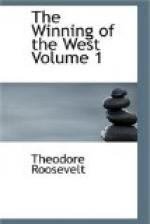Lewis’ troops formed a typical backwoods army, both officers and soldiers. They wore fringed hunting-shirts, dyed yellow, brown, white, and even red; quaintly carved shot-bags and powder-horns hung from their broad ornamented belts; they had fur caps or soft hats, moccasins, and coarse woollen leggings reaching half-way up the thigh.[15] Each carried his flint-lock, his tomahawk, and scalping-knife. They marched in long files with scouts or spies thrown out in front and on the flanks, while axe-men went in advance to clear a trail over which they could drive the beef cattle, and the pack-horses, laden with provisions, blankets, and ammunition. They struck out straight through the trackless wilderness, making their road as they went, until on the 21st of the month[16] they reached the Kanawha, at the mouth of Elk Creek. Here they halted to build dug-out canoes; and about this time were overtaken by the companies of Russell and Shelby. On October 1st[17] they started to descend the river in twenty-seven canoes, a portion of the army marching down along the Indian trail, which followed the base of the hills, instead of the river bank, as it was thus easier to cross the heads of the creeks and ravines.[18]
They reached the mouth of the river on the 6th,[19] and camped on Point Pleasant, the cape of land jutting out between the Ohio and the Kanawha. As a consequence the bloody fight that ensued is sometimes called the battle of Point Pleasant, and sometimes the battle of the Great Kanawha. Hitherto the Indians had not seriously molested Lewis’ men, though they killed a settler right on their line of march, and managed to drive off some of the bullocks and pack-horses.[20]
The troops, though tired from their journey, were in good spirits, and eager to fight. But they were impatient of control, and were murmuring angrily that there was favoritism shown in the issue of beef. Hearing this, Lewis ordered all the poorest beeves to be killed first; but this merely produced an explosion of discontent, and large numbers of the men in mutinous defiance of the orders of their officers began to range the woods, in couples, to kill game. There was little order in the camp,[21] and small attention was paid to picket and sentinel duty; the army, like a body of Indian warriors, relying for safety mainly upon the sharp-sighted watchfulness of the individual members and the activity of the hunting parties.
On the 9th Simon Girty[22] arrived in camp bringing a message from Lord Dunmore, which bade Lewis meet him at the Indian towns near the Pickaway plains. Lewis was by no means pleased at the change, but nevertheless prepared to break camp and march next morning. He had with him at this time about eleven hundred men.[23]
His plans, however, were destined to be rudely forestalled, for Cornstalk, coming rapidly through the forest, had reached the Ohio. That very night the Indian chief ferried his men across the river on rafts, six or eight miles above the forks,[24] and by dawn was on the point of hurling his whole force, of nearly a thousand warriors[25] on the camp of his slumbering foes.




